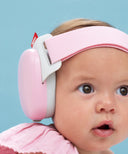We are seeing it more and more often; children wearing head phones in the classroom. Not the type that play music, but special children’s earmuffs. They make children less distracted and better able to concentrate. According to research, this improves their academic performance. According to schools that issue their students with earmuffs, the results are fantastic. A lot of parents are also buying them for their children. They seem to get more and more popular. Why is that?
MORE QUICKLY DISTRACTED
Some children become more quickly distracted in the classroom than others. Some of these children have been diagnosed with ADHD or ADD. People with ADD have problems concentrating. People with ADHD also have problems concentrating but are also hyperactive. It seems that increasing numbers of children have problems concentrating. It’s not that strange that a child should become distracted with all his classmates surrounding him. In addition, teaching is more individual than it used to be. Children are given an assignment and expected to get on with it themselves. While some children get down to work independently, others require assistance from their teacher. Or one child is engrossed in reading, while others are working in a group. They sometimes also use computers. And a lot of schools now have smartboards. All together, these things are increasing the level of distraction in the classroom.
BUSY LIVES
A busy home life can also play a part. As can going to bed too late, being in lots of clubs and meeting up with friends. Teachers say more and more students appear tired nowadays. And that means a lack of concentration. On the other hand, there are children who spend hours gaming or playing on their smartphone and who hardly spend time playing outside. These children are under-stimulated. They actually have too much energy, so they can’t sit still in their lessons. Intermingling teaching with active games and movement often works well for them. As a parent, you could agree half an hour of gaming with your child, after which it should then go off on his or her bike or play hide-and-seek. There are also children that are over-stimulated. They become anxious or stressed by all the impressions. The dynamic approach to teaching is particularly problematic to these children. For these children, earmuffs are a good solution.
SWITCHING TASKS
Children of course do not have an unending span of attention. However, there is a big difference between willing and forced concentration. Willing concentration comes very easily to children. They can spend hours playing computer games, playing hopscotch or doing arts and crafts. They choose these activities for themselves and are happy to spend time on them. Doing homework or listening to a teacher are forms of forced concentration. They do these activities ‘as a task’. Children aged six can generally spend ten minutes being forced to focus. Children aged ten or older are able to focus for twenty minutes. And children aged thirteen or older can focus for thirty minutes. Wearing earmuffs is great for increasing concentration.
Where concentration is enforced, it is important to switch between types of activity. For example, playing an educational game after a ten-year-old has spent twenty minutes reading. If your child is doing homework, it is important to switch between types of activity.
CONCENTRATION AT SCHOOL AND AT HOME
Alpine Muffy earmuffs are robust and adjustable. They ‘grow’ with your child over the years. You can also use them to protect your child’s hearing against loud noises, for example against the racket of fireworks. And at parties, festivals and concerts or at car and motorbike races. The Alpine Muffy earmuffs are available in five fashionable colours.
Concentration in the classroom



